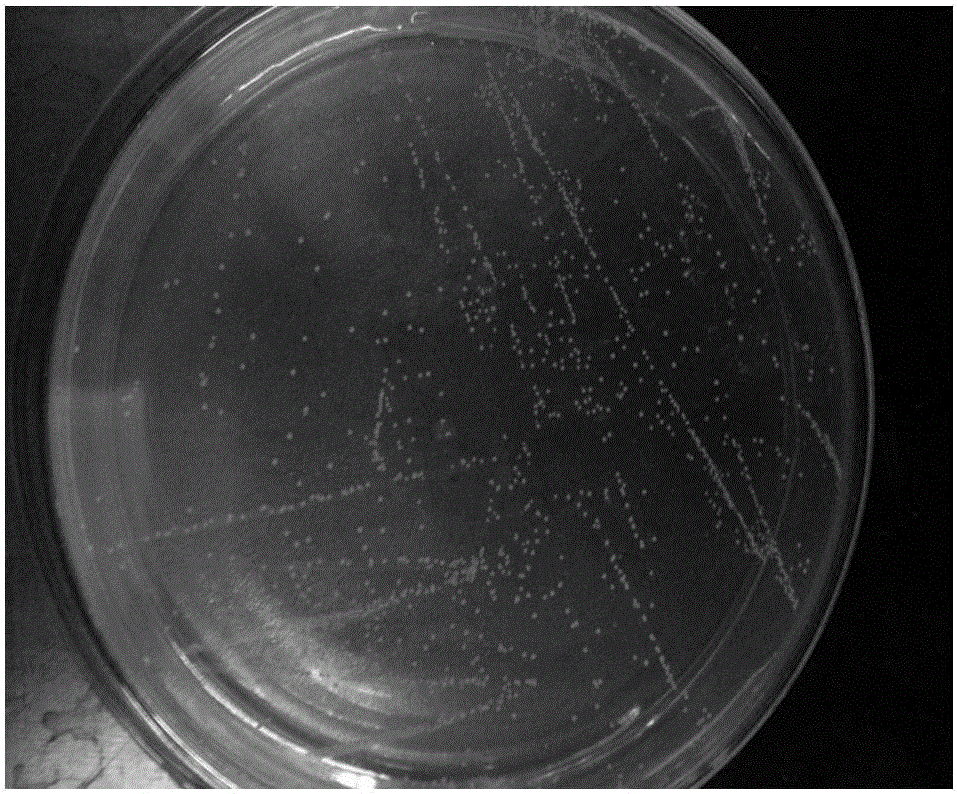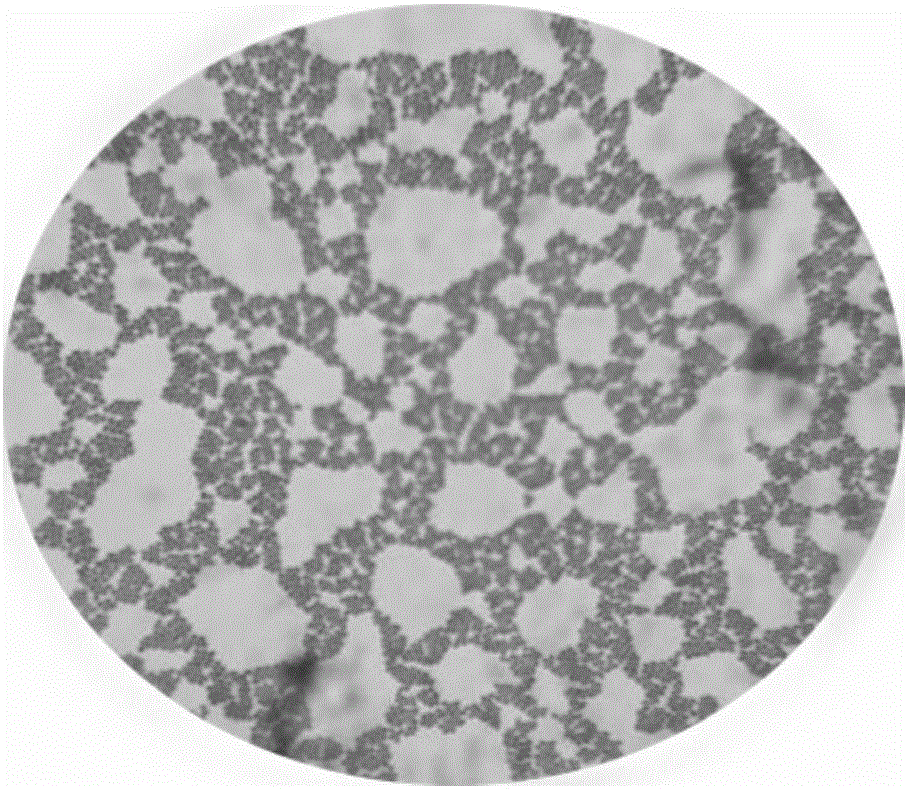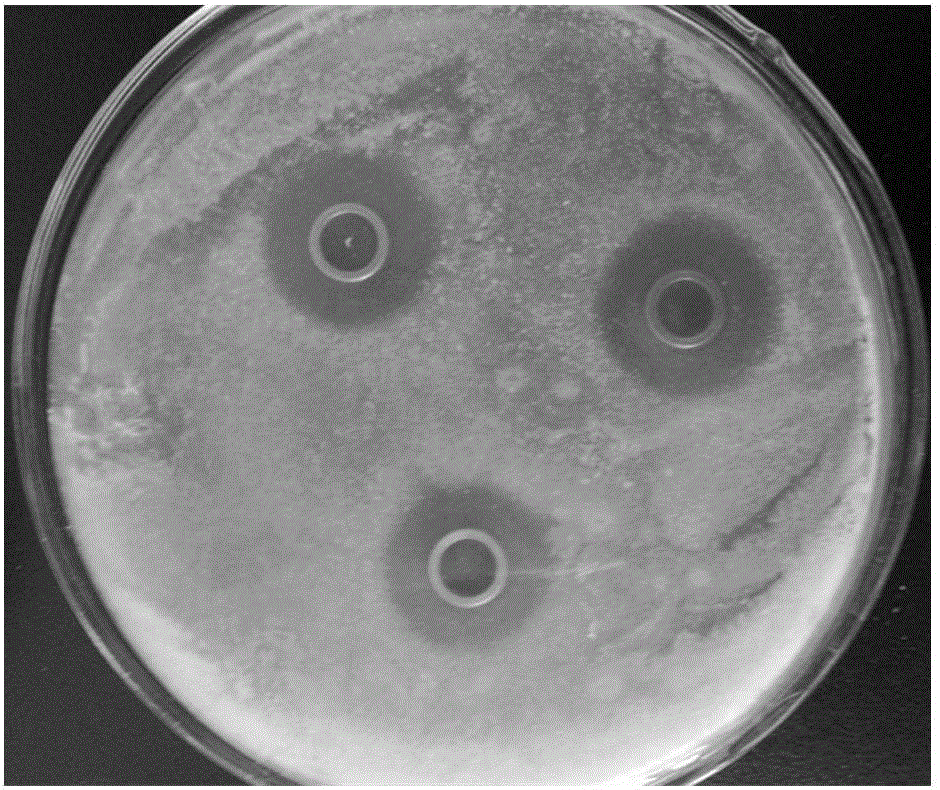Enterococcus faecium producing bacteriocin and application thereof
A technology of Enterococcus faecium and bacteriocin production, which is applied in the field of food biology to achieve good thermal stability, good tolerance, and good antibacterial effect
- Summary
- Abstract
- Description
- Claims
- Application Information
AI Technical Summary
Problems solved by technology
Method used
Image
Examples
Embodiment 1
[0035] Embodiment 1: Isolation and purification of lactic acid bacteria:
[0036] Using the conventional plate dilution method, weigh 1g of soybean paste samples and shake them fully in 10mL of sterilized normal saline for 10-fold dilution, and take samples at 10-5g / mL, 10-6g / mL, and 10-7g / mL 100 μL, spread evenly on MRS solid medium, and culture at 37°C for 24h. Pick a single colony of suspected lactic acid bacteria in MRS liquid medium and culture it at 37°C for 24h. After purification by plate streak separation, Gram staining and catalase tests were performed. Select cocci that are positive in Gram staining and negative in catalase test as tentatively designated as spherical lactic acid bacteria for puncture preservation.
[0037] The bacterium is named Enterococcus faecium (Enterococcus faecium) R1, and it was preserved on January 20, 2016 in the General Microbiology Center of China Committee for the Collection of Microbial Cultures. Address: No. 3, Yard No. 1, Beichen W...
Embodiment 2
[0038] Embodiment 2: the screening of producing bacteriocin lactic acid bacteria:
[0039] (1) Screening of bacteriostatic lactic acid bacteria
[0040] Bacteriostatic lactic acid bacteria were screened by the Oxford cup agar diffusion method.
[0041] (1) Preparation of bacterial fermentation broth: Inoculate lactic acid bacteria strains in MRS liquid medium and culture at 37°C for 24 hours. Then, according to the inoculation amount of 2%, they were transferred to the MRS liquid medium for the activation of the first-generation bacteria, and cultured at 37°C for 24h. Lactic acid bacteria are activated to three generations in the same way. The culture solution was centrifuged at 10000r / m for 10min, and the fermentation supernatant was taken for later use, and stored at 4°C.
[0042] (2) Preparation and treatment of indicator bacteria suspension: Inoculate Staphylococcus aureus into LB liquid medium and culture at 37°C for 36h-48h. Then transfer 2% of the inoculum to LB liq...
Embodiment 3
[0057] Example 3: Identification of bacteriocin-producing strains
[0058] (1) Physiological and biochemical identification of lactic acid bacteria
[0059] Physiological and biochemical tests were carried out on the screened bacteriocin-producing strain R1, and its species was initially identified. According to the description of Enterococcus faecium in "Berger's Bacterial Identification Manual (Eighth Edition)" and "Common Bacterial System Identification Manual", the strain R1 was preliminarily determined to be Enterococcus faecium. The specific results are shown in Table 3.
[0060] Table 3 Physiological and biochemical identification results of Enterococcus faecium R1
[0061]
[0062] (2) 16SrDNA sequence homology analysis and identification
[0063] ⑴Extraction of total DNA and detection of purity
[0064] Genomic DNA of the tested strains was extracted by the optimized CTAB method. The specific operation steps are as follows:
[0065] ①Take 1.5 mL of the bacter...
PUM
| Property | Measurement | Unit |
|---|---|---|
| diameter | aaaaa | aaaaa |
Abstract
Description
Claims
Application Information
 Login to View More
Login to View More - R&D
- Intellectual Property
- Life Sciences
- Materials
- Tech Scout
- Unparalleled Data Quality
- Higher Quality Content
- 60% Fewer Hallucinations
Browse by: Latest US Patents, China's latest patents, Technical Efficacy Thesaurus, Application Domain, Technology Topic, Popular Technical Reports.
© 2025 PatSnap. All rights reserved.Legal|Privacy policy|Modern Slavery Act Transparency Statement|Sitemap|About US| Contact US: help@patsnap.com



